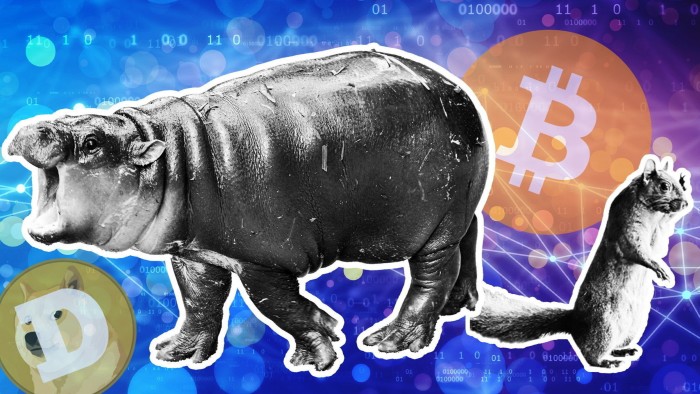Cryptocurrencies representing a euthanised grey squirrel, a Thai pygmy hippopotamus and a cartoon dog have exploded in value since last month’s US presidential election, as Donald Trump’s victory triggers a surge in speculation in so-called memecoins.
The market for tokens representing online viral moments has expanded rapidly since early November as traders bet that Trump’s administration will usher in more crypto-friendly attitudes and regulation in Washington.
More established memecoins such as Dogecoin have outperformed bitcoin, the world’s biggest cryptocurrency, over the past month and have been joined by a plethora of new coins that have been launched in the days following Trump’s win.
Critics, including some of the biggest figures in the crypto industry, argue that memecoins are little more than frothy assets representing the market’s over-exuberance, and are reminiscent of the craze for non-fungible tokens — digital ownership certificates for digital artwork — during the crypto bubble of 2021.
“I am not against memes. But meme coins are getting ‘a little’ weird now,” Changpeng Zhao, founder of crypto exchange Binance, wrote on X last week.
There are millions of memecoins, which can easily be set up using online memecoin generators. They have no business model, cash flow or fundamental value, and do not give their owners a share of any physical asset. Instead, these highly volatile tokens rely on their popularity among traders to generate liquidity.
“They have no value, they never will have value,” Charles Hoskinson, co-founder of the Cardano blockchain, said about memecoins recently. “There’s no utility behind them, nobody wants them — when they lose their lustre they go to zero.”
All memecoins require niche knowledge of internet culture: MOO DENG refers to a Thai pygmy hippo who went viral because of her playful energy; PNUT refers to an orphaned squirrel called Peanut who was euthanised by New York authorities, and whose death Trump was “fired up” about, according to vice-president-elect JD Vance; CHILLGUY represents a meme of a relaxed, cartoon dog with his hands in his pockets, which is going viral on TikTok.
The total market value of CHILLGUY has reached $466mn since it was created two weeks ago. It received a boost when MrBeast, the world’s most popular YouTuber, wrote on X last week that it was the “biggest meme of our lifetimes”.
The memecoin frenzy has inspired others to get involved. Haliey Welch, who went viral this year as Hawk Tuah Girl, said last week she will soon launch a token “to unite her entire community”.
The market size of PNUT has hit $1.2bn, while PEPE, referencing a comic frog character, has a market cap of $8.2bn — more than that of British supermarket chain Sainsbury’s. BONK, a cartoon dog made after the collapse of exchange FTX in an effort to cheer up traders using the Solana blockchain, has a market cap of $3bn.
Traders are excited by the election of Trump and the prominent position secured by billionaire backer Elon Musk, who often posts and reacts to popular memes on his social media platform X.
Trump appointed the world’s richest man to run a new US Department of Government Efficiency. Its name is a nod to Dogecoin, which was originally created as a satire on the industry in 2013. Considered the world’s first memecoin, it is a Musk favourite.
Since the election, Dogecoin has rocketed about 140 per cent, giving it a value of roughly $60bn — more than that of US retailer Target or Swiss miner and commodities trader Glencore.
“Ninety-nine per cent of them [memecoins] are pump and dumps,” said Ilan Solot, co-head of digital assets at Marex Solutions. “They’re a very, very specific game . . . The game is to get in and get out before others get out,” he added.
Anyone can launch a meme coin.
Creators typically pick a blockchain on which to build the token, while online memecoin generators help users create coins without needing any coding skills. Creators can decide the token’s supply and how much of it they want to keep themselves, then list the coin online on decentralised or centralised exchanges. Building hype and interest helps boost the price of memecoins, allowing early holders to cash out when prices surge. But 89 per cent have a market value of less than $1,000, according to a BDC Consulting report.
“Most of these fail and have no liquidity,” said Adam Morgan McCarthy, research analyst at Kaiko. But “these things are like Lazarus if a community gets behind them in force”.
Crypto exchanges are rushing to capitalise on the trend. Gemini, Kraken and Binance are among the venues rapidly listing new tokens and trading pairs, which allows a token to be traded against another.
“It’s an interesting trend that we shouldn’t just dismiss as ‘oh it’s speculation’,” said Hong Fang, president of crypto exchange OKX. “It’s all about attention and how much people believe in certain things and that gets for the first time reflected in the market, in price.”
But others see parallels with the speculative frenzy shortly before the collapse of the NFT market in 2022.
“It’s got a little bit silly and it feels . . . like what happened towards the end of the NFT market,” said Geoff Kendrick, global head of digital assets research at Standard Chartered.
“At some point, something will happen which will unleash the house of cards and it’ll collapse.”
Read the full article here

